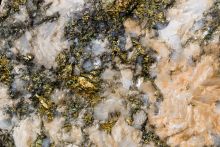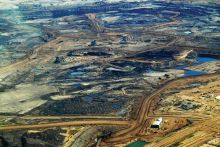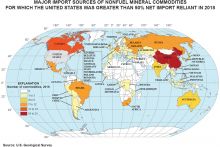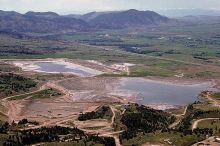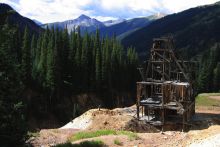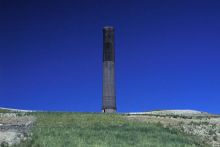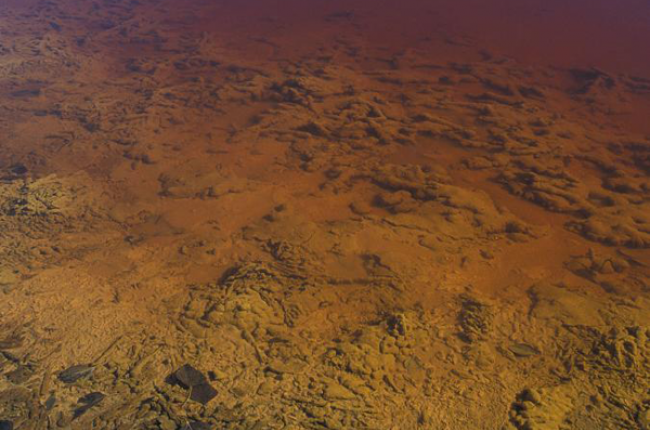
Water flowing through active or abandoned mine sites can become polluted by the material being mined[1]. By far the most common mine drainage problem is that of acid mine drainage (AMD). Sulfuric acid is produced when water interacts with sulfur-bearing materials in the presence of oxygen and common bacteria[1]. The acidic water formed by this process can dissolve many metals in bioavailable forms, posing a threat to humans and wildlife[2]. If AMD gets into surface waterways, both the acidity and metal content can produce significant environmental problems over large distances[2].
There are a variety of approaches to preventing and cleaning up acid mine drainage. Most of these focus on trying to neutralize the acid, prevent exposure of mine materials to oxygen and flowing/percolating water, or otherwise prevent bacteria from catalyzing the necessary reactions. Some common methods include:
- Reclamation of contaminated land[2] by (1) adding lime or other alkaline materials to neutralize the acidity, and (2) adding uncontaminated top soil, planting vegetation, and modifying slopes to stabilize the soil and reduce infiltration of surface water into underlying contaminated material.
- Soil removal to relocate contaminated material to new sites where it can be monitored and treated[2].
- Direct treatment of the contaminated water, either through treatment plants (where lime or other neutralizing materials are added to reduce the acidity, which causes metals to precipitate out of the contaminated water) or artificial wetlands (which help sequester contaminated material in place, and where microbial action produces oxygen-free conditions to help prevent further sulfuric acid formation)[2].
- Filling in abandoned mines with materials that will prevent the formation of AMD. This can include flooding the mines with water to remove the oxygen necessary to form AMD, or filling in mines with alkaline materials to prevent the formation of acidic water[2,3].
- Relocation and isolation of mine waste that may produce AMD if allowed to react with water. This often involves isolating the waste from interaction with groundwater by moving the waste above the water table, treating it, and covering it with a layer of impermeable material to keep out surface water[3].
- Bacteria control – certain common bacteria substantially speed up the formation of AMD. Some efforts to prevent AMD involve the use of bactericides to kill these bacteria, or the addition of organic waste to provide an alternative energy source for some of these bacteria and produce oxygen-free conditions that prevent the formation of sulfuric acid[3].
- Diverting water from the mine site to prevent it from running through AMD-forming materials[3].
- Disposing mine waste underwater to prevent exposure to oxygen[3].
In addition to the methods listed above, a wide variety of alternative methods have been employed to prevent or treat acid mine drainage. See below for resources that provide a comprehensive discussion of treatment options.
References
1 Abandoned Mine Drainage Environmental Protection Agency
2 Metal Mining and the Environment American Geosciences Institute
3 Handbook of Technologies for Avoidance and Remediation of Acid Mine Drainage National Mine Land Reclamation Center, West Virginia University
Learn More
- Abandoned Mine Drainage (Website), Environmental Protection Agency
Introduction to Abandoned Mine Drainage with links to supplementary fact sheets, reports, and information resources
- Handbook of Technologies for Avoidance and Remediation of Acid Mine Drainage (Handbook), National Mine Land Reclamation Center, West Virginia University
1998 handbook covering the wide range of AMD cleanup and avoidance techniques. Despite its age, this handbook provides an unusually extensive treatment of the subject and is still highly relevant to AMD issues
- Acid Drainage Technology Initiative (Website), Office of Surface Mining Reclamation and Enforcement, U.S. Department of the Interior
Information about ADTI and how it is addressing the pervasive problem of acid mine drainage
- National Mine Land Reclamation Center (Website), West Virginia Water Research Institute
Website for this national center focused on issues related to abandoned coal and metal mines
- Abandoned Mine Site Characterization and Cleanup Handbook (Handbook), Environmental Protection Agency
Comprehensive handbook for assessing and remediating abandoned mine sites
- Acid Mine Drainage Abatement and Treatment Plans (Handbook), Ohio Department of Natural Resources
Guidance document used in Ohio for developing AMD abatement and treatment plans
- USGS Mine Drainage Activities (Website), U.S. Geological Survey
USGS programs, activities, projects, publications, and meetings on mine drainage issues


